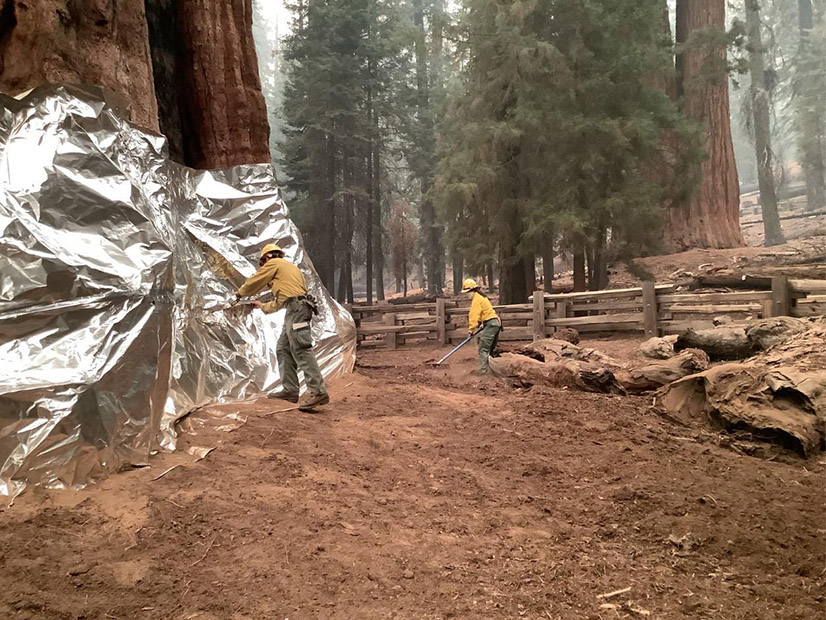
California Gov. Gavin Newsom signed two dozen bills dealing with climate change, renewable energy and wildfire prevention on Thursday as he stood amid the smoke of the KNP Complex of wildfires burning in Sequoia National Park.
Newsom also touted billions in spending associated with the bills and this summer’s budget plan, which he signed in July. The governor and lawmakers have continued discussing specifics of the 2021-22 spending plan, most of which were included in a budget trailer bill, Senate Bill 170, that Newsom signed Thursday.
“Today’s signing represents about a $15 billion commitment to climate resiliency,” Newsom said during his announcement and press conference in the national park. “It’s an unprecedented investment by any state in U.S. history.”
Previous allocations and Thursday’s updates devote $1.5 billion to reduce the risk of wildfires by improving the health of forests and wildlands, including projects to create strategic fuel breaks, reduce forest fuels and harden at-risk communities against wildfires.

“Climate change is making droughts more common and more severe,” a statement by the governor’s office said.
The spending package includes $3.7 billion over three years to bolster the state’s resilience against “multi-faceted climate risks, including extreme heat and sea level rise” and $1.1 billion over two years to support sustainable agriculture practices that reduce methane emissions from livestock and greenhouse gas emissions from agricultural equipment.
The state’s decision to spend a history-making $3.9 billion to boost adoption of zero-emission vehicles was also part of the spending spree, funded with billions of dollars in unexpected surplus revenue. The state plans to spend $2 billion for medium- and heavy-duty ZEV incentives and infrastructure and $1.2 billion to promote consumer adoption of zero-emission passenger vehicles. (See Calif. Earmarks $3.9B for ZEVs Through 2024.)
24 Bills Signed
Newsom signed a spate of policy-making measures Thursday in addition to the budget trailer bill.
The governor signed Assembly Bill 525, by Assemblyman David Chiu, instructing the California Energy Commission (CEC) to develop planning goals for offshore wind generation for 2030 and 2045 and to coordinate with state agencies to develop a strategic plan for OSW development, to be submitted to the legislature by June 2023. (See OSW, GHG Bills Go to California Governor.)
The Biden administration announced in May it plans to offer leases for the state’s first offshore wind areas — a 399-square-mile block off Morro Bay in Central California that could support 3 GW of wind generation and the Humboldt Call Area off Northern California, large enough for an additional 1.6 GW. (See BOEM to Offer Leases for Calif. Offshore Wind.)
Newsom signed SB 596, ordering the California Air Resources Board (CARB) to develop a strategy for decarbonizing cement production by July 2023 and to set a goal of achieving net-zero greenhouse gas emissions no later than Dec. 31, 2045.
“California is now the leader in driving decarbonization of the cement industry — a crucial material in the built environment, but one that accounts for 7% of all global greenhouse gas emissions and is one of the most challenging industries to decarbonize,” Sen. Josh Becker, the bill’s author, said in a statement Thursday. (See Challenges Loom for Decarbonizing Concrete.)
The CEC recently began looking more seriously at decarbonizing building materials as part of the state’s GHG reduction strategy. Cement production accounted for 1.8% of GHG emissions in 2017, according to CARB. (See CEC Targets ‘Embodied Carbon’ in Buildings.)
Newsom also signed the following measures:
- AB 322, by Assemblymember Rudy Salas, requires the CEC to consider bioenergy projects for biomass conversion in its investment planning process for the Electric Program Investment Charge (EPIC) program.
- SB 27, by Sen. Nancy Skinner, creates the California Carbon Sequestration and Climate Resilience Project Registry to maintain a list of eligible but unfunded projects, “which then may be funded by public or private entities in order to mitigate California’s greenhouse gas emissions and improve climate resilience,” a Senate analysis of the bill said.
- SB 23, by Sen. Henry Stern, orders the CEC to submit to lawmakers an assessment by Dec. 31, 2023, of “firm zero-carbon resources that support a clean, reliable, and resilient electrical grid and will help achieve the existing statutory goal of ensuring renewable energy and zero-carbon resources supply 100% of all retail sales of electricity to California customers” by the end of 2045, a Senate analysis said.
- SB 109, by Sen. Bill Dodd, creates the Office of Wildfire Technology Research and Development at the California Department of Forestry and Fire Protection (Cal Fire) to evaluate emerging firefighting technology.
- AB 697, by Assemblymember Ed Chau, allows the state to plan and implement forest restoration projects on national forest lands through an expanded Good Neighbor Authority Program.
- AB 9, by Assemblymember Jim Wood, establishes new state entities and officials charged with preventing wildfires. It creates the Regional Forest and Fire Capacity Program in the state Department of Conservation, establishes the position of deputy director of Community Wildfire Preparedness and Mitigation in the Office of the State Fire Marshal and transfers some fire safety duties from Cal Fire, which has its hands full fighting fires, to the fire marshal’s office.


